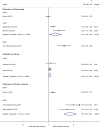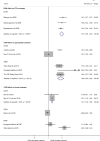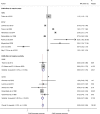The impact of community-delivered models of malaria control and elimination: a systematic review
- PMID: 31387588
- PMCID: PMC6683427
- DOI: 10.1186/s12936-019-2900-1
The impact of community-delivered models of malaria control and elimination: a systematic review
Abstract
Background: Community-delivered models have been widely used to reduce the burden of malaria. This review aimed to explore different community-delivered models and their relative effectiveness in terms of coverage and malaria-metric outcomes in order to inform the design and implementation of Community Health Worker (CHW) programmes for malaria control and elimination.
Methods: A systematic review of studies investigating the impact of community-delivered models on coverage and malaria-metric (parasitaemia and hyperparasitaemia, malaria case and mortality, anaemia, and fever) outcomes compared to non- community-delivered models was undertaken by searching in five databases of published papers and grey literature databases. Data were extracted from studies meeting inclusion and quality criteria (assessed using relevant tools for the study design) by two independent authors. Meta-analyses were performed where there was sufficient homogeneity in effect and stratified by community-delivered models to assess the impact of each model on coverage and malaria-metric outcomes.
Results: 28 studies were included from 7042 records identified. The majority of studies (25/28) were performed in high transmission settings in Africa and there was heterogeneity in the type of, and interventions delivered as part of the community-delivered models. Compared to non- community-delivered models, community-delivered models increased coverage of actual bed net usage (Relative Risk (RR) = 1.64 95% CI 1.39, 1.95), intermittent preventive treatment in pregnancy (RR = 1.36 95% CI 1.29, 1.44) and appropriate and timely treatment of febrile children, and improved malaria-metric outcomes such as malaria mortality (RR = 0.58 95% CI 0.52, 0.65). However, the considerable heterogeneity was found in the impact of community-delivered models in reducing, parasitaemia and hyperparasitaemia prevalence, anaemia incidence, fever prevalence and malaria caseload. Statistical comparisons of different community-delivered models were not undertaken due to the heterogeneity of the included studies in terms of method and interventions provided.
Conclusion: Overall, the community-delivered model is effective in improving the coverage of malaria interventions and reducing malaria-associated mortality. The heterogeneity of the community-delivered models and their impact on malaria-metric indices suggests that evidence for context-specific solutions is required. In particular, community-delivered models for malaria elimination, integrated with services for other common primary health problems, are yet to be evaluated.
Keywords: Community health worker; Community-delivered model; Coverage; Malaria; Malaria-metric outcomes.
Conflict of interest statement
The authors declare that they have no competing interests.
Figures






References
-
- WHO . World Malaria Report 2018. Geneva: World Health Organization; 2018. p. 210.
-
- WHO . Community health workers: What do we know about them? Geneva: World Health Organization; 2007.
-
- WHO . World Malaria Report 2015. Geneva: World Health Organization; 2015.
Publication types
MeSH terms
LinkOut - more resources
Full Text Sources
Medical

